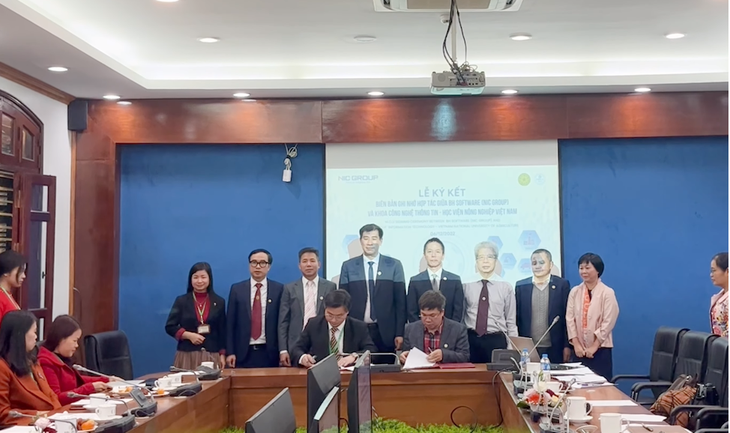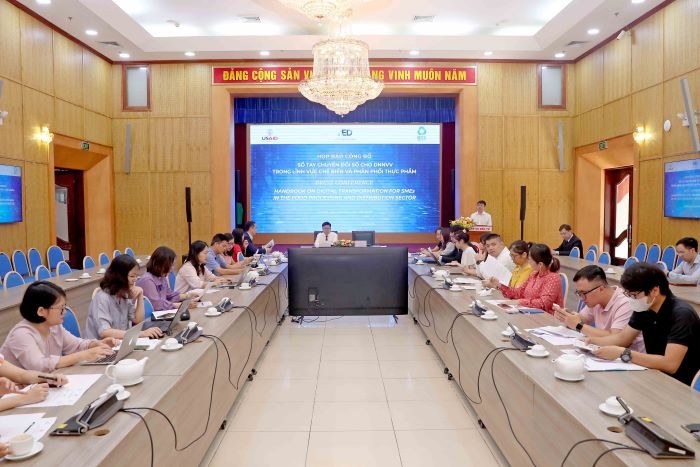(VOVWORLD) - In the current rapid pace of the 4th Industrial Revolution, application of digital transformation and technology to connect and distribute products on multiple channels is one of the most effective solutions implemented by many businesses and industries. Many small and medium-sized enterprises in the food processing and distribution sector in Vietnam have also followed suit.
 NIC signs a contract with Vietnam National University of Agriculture on digital transformation in the agricultural sector in late 2022. (Photo: NIC) NIC signs a contract with Vietnam National University of Agriculture on digital transformation in the agricultural sector in late 2022. (Photo: NIC) |
NIC Group is a multi-industry enterprise, providing products and services in multiple fields with factories in many provinces and cities. These include Bac Giang, Yen Bai, Quy Nhon, Binh Duong, Binh Phuoc, and Gia Lai province. NIC owns 10,000 hectares for growing and processing cashew nuts, cinnamon, and pepper. When the market gradually became saturated, the group expanded its fruit product line to include durian, passion fruit, and mango.
During this process, NIC came to understand that in addition to maintaining domestic distribution channels, it’s important to promote exports, focusing on cross-border e‑commerce, which means increasing digital transformation in export activities.
“We have paid special attention to applying information technology and digitization to manage the agricultural supply chain. It’s an urgent issue. NIC’s agricultural trade is not just oriented domestically but is also for export, so using digital transformation is very important,” Dang Manh Pho of the NIC Group said.
Like NIC, IGV Joint Stock Company also considers digital transformation and modern technology solutions as ways to make the company’s products better known throughout the market. The company’s Thach Co Tra (Ancient Tea Jelly) product line is an example. Using the same ancient Shan Tuyet tea ingredients grown between the Tay Con Linh and Chieu Lau Thi mountain ranges in the Ha Giang karst plateau, IGV has created many different product lines with impressive names and designs. In addition to traditional sale channels, the company has promoted their products online and through other digital channels. As a result, its revenue has increased sharply.
Vietnamese management agencies have implemented several solutions to help businesses promote and sell products via technology applications. The Ministry of Planning and Investment and the Ministry of Agriculture and Rural Developmental debuted the “Digital Transformation Handbook for Small and Midsize Enterprises (SME) in the Food Processing and Distribution Sector” in June.
“The handbook helps farmers understand the importance of digitization through things such as traceability, investing in science and technology, improving product value as well as increasing opportunities to access export market,” Nguyen Duc Trung, Deputy Director of the Department of Enterprise Development, the Ministry of Planning and Investment, said.
 The launch ceremony for the “Digital Transformation Handbook for Small and Midsize Enterprises (SME) in the Food Processing and Distribution Sector” in June, 2023. (Photo: MPI) The launch ceremony for the “Digital Transformation Handbook for Small and Midsize Enterprises (SME) in the Food Processing and Distribution Sector” in June, 2023. (Photo: MPI) |
The global processed food market is estimated to grow at 3.8% until 2028. The Vietnamese market is no exception. The Vietnamese Government considers food processing one of the priority industries which needs effective solutions for data collection, analysis, and traceability, transportation management, warehouse and inventory management, product quality management, and multi-channel sales management. Multi-channel sales and traceability have been included to increase revenue, strengthen chain links, especially in the current context.
“Data from cultivating agriculture and production from livestock, fisheries and forestry must be digitized to connect business entities and management agencies, and minimize costs. We can tell stories about production, farming, and processing through digital transformation. Consumers also know products through digital applications. These are the stories that increase the value of the product,” Nguyen Quoc Toan, Director of the Center for Digital Transformation and Agricultural Statistics, Ministry of Agriculture and Rural Development, said.
Practical stories from NIC, IGV and those involved with interdisciplinary cooperation, as well as contributions such as the Digital Transformation Handbook, show that businesses and management agencies have all been making progress in digital transformation, to promote and distribute food for both domestic use and for export. This is the right step that needs to be promoted more strongly and effectively, especially amid numerous difficulties and unpredictable developments in the world economy.